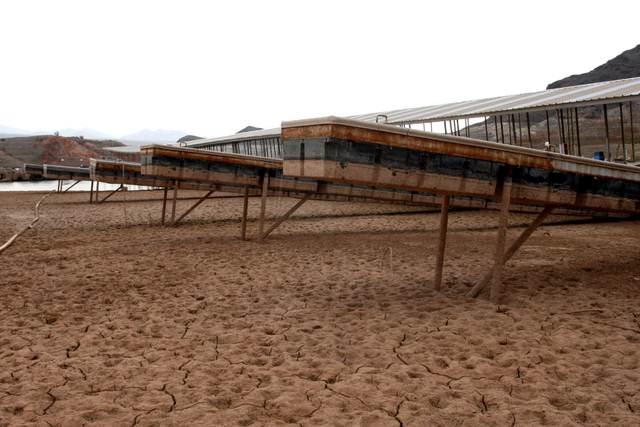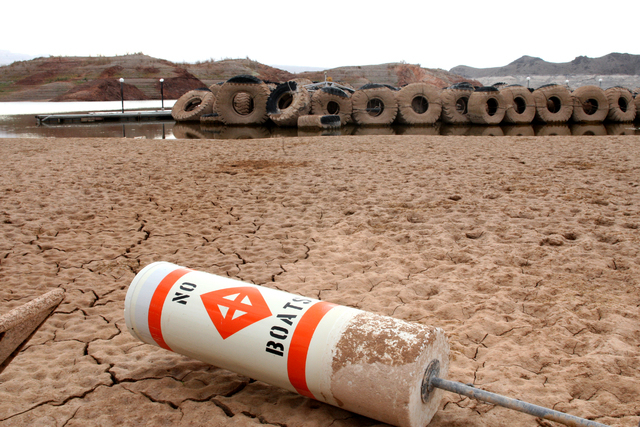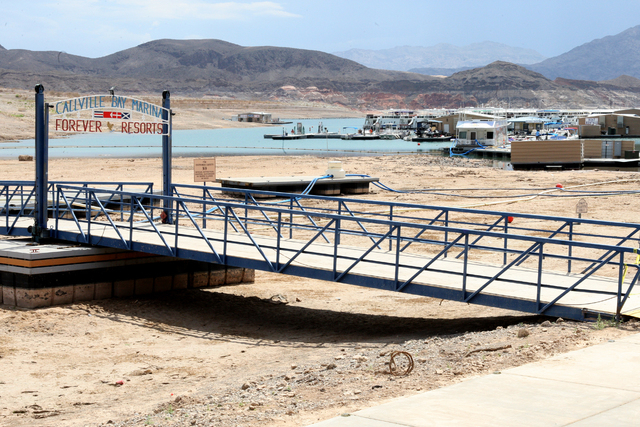Colorado River drought impact tracked from space
The impact of drought on the Colorado River is so severe you can see the weight of it from space.
Actually what you can see is the absence of weight.
A new satellite-based study by NASA and the University of California, Irvine shows the worst impact of the continuing drought on the Colorado has been to groundwater resources in the basin, which account for 75 percent of the water lost since late 2004 — far more than Lake Mead and its famous bathtub ring.
“This is a lot of water to lose. We thought that the picture could be pretty bad, but this was shocking,” said Stephanie Castle, a water resources specialist at UC Irvine and the study’s lead author. “We don’t know exactly how much groundwater we have left, so we don’t know when we’re going to run out.”
Researchers reached their conclusions by using the space agency’s Gravity Recovery and Climate Experiment — GRACE — satellites to track changes in mass caused by rising or falling groundwater levels, which influence the strength of the local gravitational field.
By periodically measuring gravity’s pull on the twin satellites as they pass over specific areas, GRACE revealed changes in the region’s water storage over time. It’s like having a giant scale in the sky, said another of the study’s authors, Jay Famiglietti, a UC Irvine professor now working as a senior water cycle scientist at NASA’s Jet Propulsion Laboratory.
Although water in the river and its reservoirs is closely monitored and managed by the U.S. Bureau of Reclamation, pumping from underground aquifers is regulated by individual states and not always well-documented.
“There’s only one way to put together a very large-area study like this, and that is with satellites,” Famiglietti said. “There’s just not enough information available from well data to put together a consistent, basin-wide picture.”
The basin has since 2000 been locked in a drought that ranks as the driest 14-year period in a century. Tree-ring studies suggest the current drought might also be among the worst in 500 years or more. Lake Mead’s surface has dropped by more than 130 feet over the past 15 years, to a record-low level not seen since the reservoir was being filled in 1937.
The situation is worsened because the river was overappropriated when it was first divvied up among seven Western states and Mexico around the time Hoover Dam was built.
Monthly satellite measurements of the change in water mass from December 2004 to November 2013 show the Colorado River basin lost nearly 53 million acre-feet of water, almost double the total volume of Lake Mead when full. More than three-quarters of the loss — about 41 million acre-feet — came from groundwater aquifers, which replenish slowly but are tapped by farmers and some communities.
In that respect, the study’s findings help document the extent to which those living and growing crops in the basin depend on groundwater to get by.
“We found a surprisingly high and long-term reliance on groundwater to bridge the gap between supply and demand,” Famiglietti said.
One acre-foot is enough to supply two average valley homes for just more than a year. Nevada is allowed to use 300,000 acre-feet of Colorado River water annually — enough, when stretched through reuse, to provide about 90 percent of the Las Vegas Valley’s water supply. The rest is pumped from beneath the valley to meet peak summer demand.
The local aquifer is not at risk of depletion anytime soon because the Southern Nevada Water Authority, and the Las Vegas Valley Water District before it, have pumped unused river water into the ground since 1987, effectively banking it for future use while reversing some damage done years earlier when the local watershed was regularly overpumped.
“We’re actually a little more worried about popping swimming pools out of the ground (by overfilling the aquifer) than we are about depleting the groundwater reservoir,” water authority spokesman Scott Huntley said.
It’s a different story across the basin.
Famiglietti called the Colorado “the water lifeline of the Western United States,” one that supplies tens of millions of people and billions of dollars in agricultural production every year. But he said the rapid depletion rate of groundwater will compound the problem of short supply by leading to further decline in Colorado River stream flow amid population growth across the region and declining mountain snowpack.
A lot of groundwater is being used in the drought-stricken river basin.
“Much of it is nonrenewable, so it’s not coming back,” Famiglietti said. “So how do you bring groundwater into the water management discussion? Because we are not getting by in the basin with just the stream flow and the snow melt.”
The study has been accepted for publication in the journal Geophysical Research Letters, which posted the manuscript online Thursday for review by other researchers.
Contact Henry Brean at hbrean@reviewjournal.com or 702-383-0350. Follow @RefriedBrean on Twitter.




















